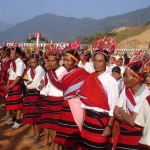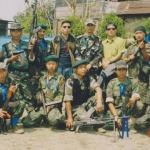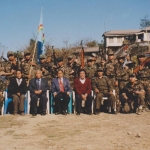Kaka D. Iralu
Originally published on October 17, 2009, on Kaka D. Iralu’s website.
South Asian history is an ancient history with its roots going as far back as 5000 BC. However by a tragic twist of political and historical events, this ancient history had been tempered with and even almost rewritten in the middle of the 20th century by the Colonial powers of Europe. In this turn of events, South Asian history was re-written to begin again from 1947. In the process, South Asian history in general and the Indo-Naga history in particular was made to begin afresh with the Indian Independence Act of 1947. This was done by the departing British imperial power through the Government of India Act 1935 and the Indian Independence Act of 1947. Through these Acts, three modern nation states that had never existed in South Asian history were created by the British in collaboration with the Indian National Congress, the All India Muslim League and the Anti- Fascist People’s Freedom League of Burma. The creation of these modern nation states was to the detriment of many smaller nations in South Asia and had horrifying consequences on them.
Prior to the coming to South Asia of the Portuguese, Dutch, Danish, French and ultimately the British from the 16th to the 20th centuries, there never existed any kingdoms called India, Burma or Pakistan in the south Asian Sub-Continent’s history. These modern nation states created by the British were formerly simply known as The Ava kingdom, Hindustan or The Mughal Empire and Bengal province. However with the departure of the British in 1947, these three huge modern nation states were created in South Asia. And into the bellies of these newly created giant nations were incorporated, smaller South Asian nations who formerly had their own independent national histories and independent geographical territories before the transfer of power. But after the transfer of power, these smaller nations were declared as Burmese, Indians and Pakistanis. Some of these smaller nations voluntarily joined the new unions but others were against their expressed wills, forcefully integrated with the new Unions. Thus in Burma, the Kachins, Karens, Shans, Mons, Was etc became Burmese citizens while in India, Independent royal kingdoms like the Manipuries the Ahoms, the Tripuries, the Kashmiries, Hyderabad and Junagadh became Indian citizens. In the Bengal province, the independent Chakmas of the Chitagong Hill Tracts became East Pakistanis.
As for the Nagas, they have absolutely no objections to the creation of these modern nation states if the parties concerned felt that they would have a better future by establishing these new political structures. However the objection is on the issue of forced inclusion of other independent nations who had been under the British Empire but wanted to revert back to their former independent status after the departure of the British from their South Asian Empire.
The consequences of the creation of these three modern nation states with regards to the Nagas are as follows:
The Nagas, as early as 1929, had clearly written to the British Simon Commission that before the advent of the British administration over 30% of their territories, they had been at intermittent warfare with the Manipuries to their North West and the Ahoms to their west. The memorandum went on to state that the two kingdoms had never been able to subjugate them despite of more then 700 years of conflict. The memorandum ended by pleading that, should the British decide to leave their South Asian Empire, the Nagas should be left alone “to decide their own future as in ancient times.” As a result of these statements, the British government left the Naga Hills under “excluded Areas” in the Government of India Act 1935. the Nagas also followed up their demand to be left out of the Indian Dominion by submitting six lengthy memorandums to the departing British Government before the transfer of power took place in 1947.These written documents were simultaneously followed by the submission of ten Memorandums to the incoming Indian Government before India became an Independent domain on August 15, 1947. To make things unmistakably clear, Nagas also declared their independence on 14th August and informed the UN as well as some foreign governments.
However, despite of all these political and historical events, after 15th August 1947, Nagas were told by India that from thenceforth, Nagaland had become Indian Territory and Nagas, Indian citizens.
As for the Chakmas, on 14th August 1947 they were rudely told to forget their King and their former kingdom and become East Pakistani citizens. This despite the fact that their kingdom had independently fought against the British Imperial power. Then after many years of suffering under the East Pakistani government where their lands were swamped by Bangladeshis and they were forced to become refugees in neighboring states, they were again told in 1971, after the Indo Pakistan war that thence forth they had become Bangladeshis!
Now who in the world had performed such a political magic in 1947 in which independent nations like the Nagas and others who had never been a part of India Burma or Pakistan were made to disappear into the bellies (Territories) of these giant modern nation states? Can the footprints of these smaller nations, imprinted in the soils of their own ancestral lands for thousands of years simply disappear into thin air by a simple wave of a British Magic wand called the Indian Independence Act of 1947?. In the process of rewriting this new South Asian history, and in order to let the new sovereign independent India and Pakistan have a new geographical map, Cyril John Radcliffe -a lawyer from England and a man who had never visited India, was summoned to come and draw the maps of India and Pakistan within a few weeks. What he drew in part, (particularly the Punjab and Bengal), without any special knowledge of South Asian historical and geographical facts now became the brand new maps of India and Pakistan.
Now, can such a political gimmick be accepted as historical and political facts? Today, India, Burma and Bangladesh have become the proud owners and custodians of this Britain made new brand of South Asian history. At the initial stages, armed with the huge cashes of modern weaponry that the British had bequeathed to these three newborn nations, they were able to brutally suppress any of the smaller nations who dared to challenge this historical injustice done to them. As for the Nagas, by the turn of 1954, British made Light armored tanks and heavy artillery along with 53000 Indian troops had moved into Nagaland to impose the political implications of this new South Asian history. In fact, because of this new re-writing of South Asian History, the whole of North East India and Burma has become a fierce battle field for the past six decades.
In this context, prior to 1947, Jawaharlal Nehru, the Indian historian and the author of Glimpses of World History had stated that “By the tribal areas, we mean those long stretches of land between Burma and India which belongs neither to India or Burma or any other foreign powers”. However after India’s independence and realizing the advantage of an enlarged territory, he had made a full turn about and was now insisting that all the territories handed to India by the departing British government were now Indian Territory. This England trained Barrister was now a follower of the new South Asian British version of history despite all the facts to the contrary. This was nothing short of infidelity and treachery to the facts of South Asian history as Nehru knew it. Can a fellow Asian stoop as low as this in betraying his own South Asian kith and kin for the benefit of his own country’s political and economic gains? Nehru’s descendents and India’s politicians must give a reply to the Nagas and others who have died in their thousands defying this historical and political lie. But whatever the suffering and the pain may be, Nagas will never surrender their national and geographical identities to this false South Asian history. This stand is made on the historical fact that South Asian history did not begin with The Indian Independence Act of 1947. The inter-related corollary question is: Can some Caucasian and European colonizers be allowed to re-write and re-draw Mongolian Asian history and geography and be allowed to get away with it?
As for a solution to the 62 year Indo- Naga-Burman political conflict, the solution will come only when Indian and Burmese historians and politicians acknowledge the historical fact that besides India and Burma, there were also other nations who have evolved with them in the flow of South Asian history. India and Burma must admit that they are not the sole guardians or owners of South Asian history. However, if the two governments will not admit these facts, sooner or later their claims will be challenged in an international court of law. In this challenge Britain too will be seriously implicated.
The views expressed in this article are the author’s own and do not necessarily reflect Burma Link’ policy.







